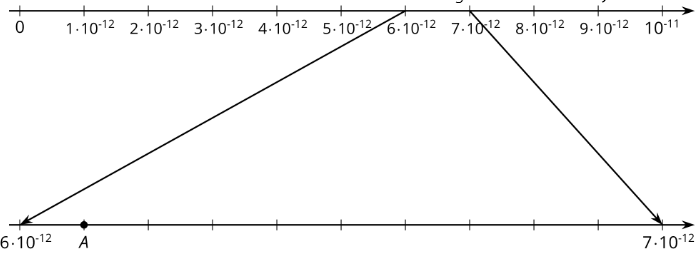7.3.3: Representing Small Numbers on the Number Line
- Page ID
- 36794
\( \newcommand{\vecs}[1]{\overset { \scriptstyle \rightharpoonup} {\mathbf{#1}} } \)
\( \newcommand{\vecd}[1]{\overset{-\!-\!\rightharpoonup}{\vphantom{a}\smash {#1}}} \)
\( \newcommand{\id}{\mathrm{id}}\) \( \newcommand{\Span}{\mathrm{span}}\)
( \newcommand{\kernel}{\mathrm{null}\,}\) \( \newcommand{\range}{\mathrm{range}\,}\)
\( \newcommand{\RealPart}{\mathrm{Re}}\) \( \newcommand{\ImaginaryPart}{\mathrm{Im}}\)
\( \newcommand{\Argument}{\mathrm{Arg}}\) \( \newcommand{\norm}[1]{\| #1 \|}\)
\( \newcommand{\inner}[2]{\langle #1, #2 \rangle}\)
\( \newcommand{\Span}{\mathrm{span}}\)
\( \newcommand{\id}{\mathrm{id}}\)
\( \newcommand{\Span}{\mathrm{span}}\)
\( \newcommand{\kernel}{\mathrm{null}\,}\)
\( \newcommand{\range}{\mathrm{range}\,}\)
\( \newcommand{\RealPart}{\mathrm{Re}}\)
\( \newcommand{\ImaginaryPart}{\mathrm{Im}}\)
\( \newcommand{\Argument}{\mathrm{Arg}}\)
\( \newcommand{\norm}[1]{\| #1 \|}\)
\( \newcommand{\inner}[2]{\langle #1, #2 \rangle}\)
\( \newcommand{\Span}{\mathrm{span}}\) \( \newcommand{\AA}{\unicode[.8,0]{x212B}}\)
\( \newcommand{\vectorA}[1]{\vec{#1}} % arrow\)
\( \newcommand{\vectorAt}[1]{\vec{\text{#1}}} % arrow\)
\( \newcommand{\vectorB}[1]{\overset { \scriptstyle \rightharpoonup} {\mathbf{#1}} } \)
\( \newcommand{\vectorC}[1]{\textbf{#1}} \)
\( \newcommand{\vectorD}[1]{\overrightarrow{#1}} \)
\( \newcommand{\vectorDt}[1]{\overrightarrow{\text{#1}}} \)
\( \newcommand{\vectE}[1]{\overset{-\!-\!\rightharpoonup}{\vphantom{a}\smash{\mathbf {#1}}}} \)
\( \newcommand{\vecs}[1]{\overset { \scriptstyle \rightharpoonup} {\mathbf{#1}} } \)
\( \newcommand{\vecd}[1]{\overset{-\!-\!\rightharpoonup}{\vphantom{a}\smash {#1}}} \)
Lesson
Let's visualize small numbers on the number line using power of 10.
Exercise \(\PageIndex{1}\): Small Numbers on a Number Line
Kiran drew this number line.

Andre said, “That doesn’t look right to me.”
Explain why Kiran is correct or explain how he can fix the number line.
Exercise \(\PageIndex{2}\): Comparing Small Numbers on a Number Line

- Label the tick marks on the number line.
- Plot the following numbers on the number line:
- \(6\cdot 10^{-6}\)
- \(6\cdot 10^{-7}\)
- \(29\cdot 10^{-7}\)
- \((0.7)\cdot 10^{-5}\)
- Which is larger, \(29\cdot 10^{-7}\) or \(6\cdot 10^{-6}\)? Estimate how many times larger.
- Which is larger, \(7\cdot 10^{-8}\) or \(3\cdot 10^{-9}\)? Estimate how many times larger.
Exercise \(\PageIndex{3}\): Atomic Scale
- The radius of an electron is about 0.0000000000003 cm.
- Write this number as a multiple of power 10.
- Decide what power of 10 to put on the right side of this number line and label it.
- Label each tick mark as a multiple of a power of 10.

Figure \(\PageIndex{3}\) - Plot the radius of the electron in centimeters on the number line.
- The mass of a proton is about 0.0000000000000000000000017 grams.
- Write this number as a multiple of a power of 10.
- Decide what power of 10 to put on the right side of this number line and label it.
- Label each tick mark as a multiple of a power of 10.

Figure \(\PageIndex{4}\) - Plot the mass of the proton in grams on the number line.
- Point \(A\) on the zoomed-in-number line describes the wavelength of a certain X-ray in meters.

Figure \(\PageIndex{5}\)- Write the wavelength of the X-ray as a multiple power of 10.
- Write the wavelength of the X-ray as a decimal.
Summary
The width of a bacterium cell is about \(2\cdot 10^{-6}\) meters. If we want to plot this on a number line, we need to find which two powers of 10 it lies between. We can see that \(2\cdot 10^{-6}\) is a multiple of \(10^{-6}\). So our number line will be labeled with multiples of \(10^{-6}\)

Note that the right side is labeled \(10\cdot 10^{-6}=10^{-5}\)
The power of ten on the right side of the number line is always greater than the power on the left. This is true for powers with positive or negative exponents.
Practice
Exercise \(\PageIndex{4}\)
Select all the expressions that are equal to
- \(4\cdot\left(\frac{1}{10}\right)\cdot\left(\frac{1}{10}\right)\cdot\left(\frac{1}{10}\right)\)
- \(4\cdot (-10)\cdot (-10)\cdot (-10)\)
- \(4\cdot 0.001\)
- \(4\cdot 0.0001\)
- \(0.004\)
- \(0.0004\)
Exercise \(\PageIndex{5}\)
Write each expression as a multiple of a power of 10:
- 0.04
- 0.072
- 0.0000325
- Three thousandths
- 23 hundredths
- 729 thousandths
- 41 millionths
Exercise \(\PageIndex{6}\)
A family sets out on a road trip to visit their cousins. They travel at a steady rate. The graph shows the distance remaining to their cousins' house for each hour of the trip.
- How fast are they traveling?
- Is the slope positive or negative? Explain how you know and why that fits the situation.
- How far is the trip and how long did it take? Explain how you know.

(From Unit 3.3.1)


